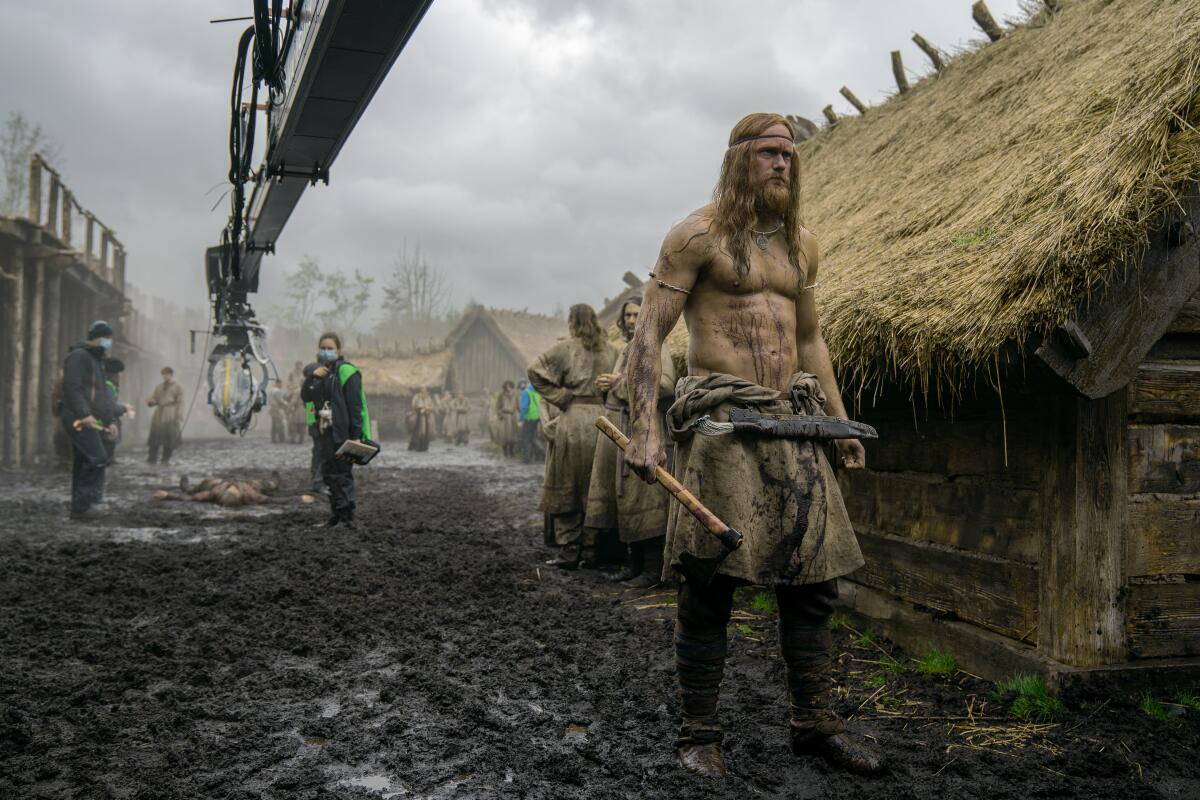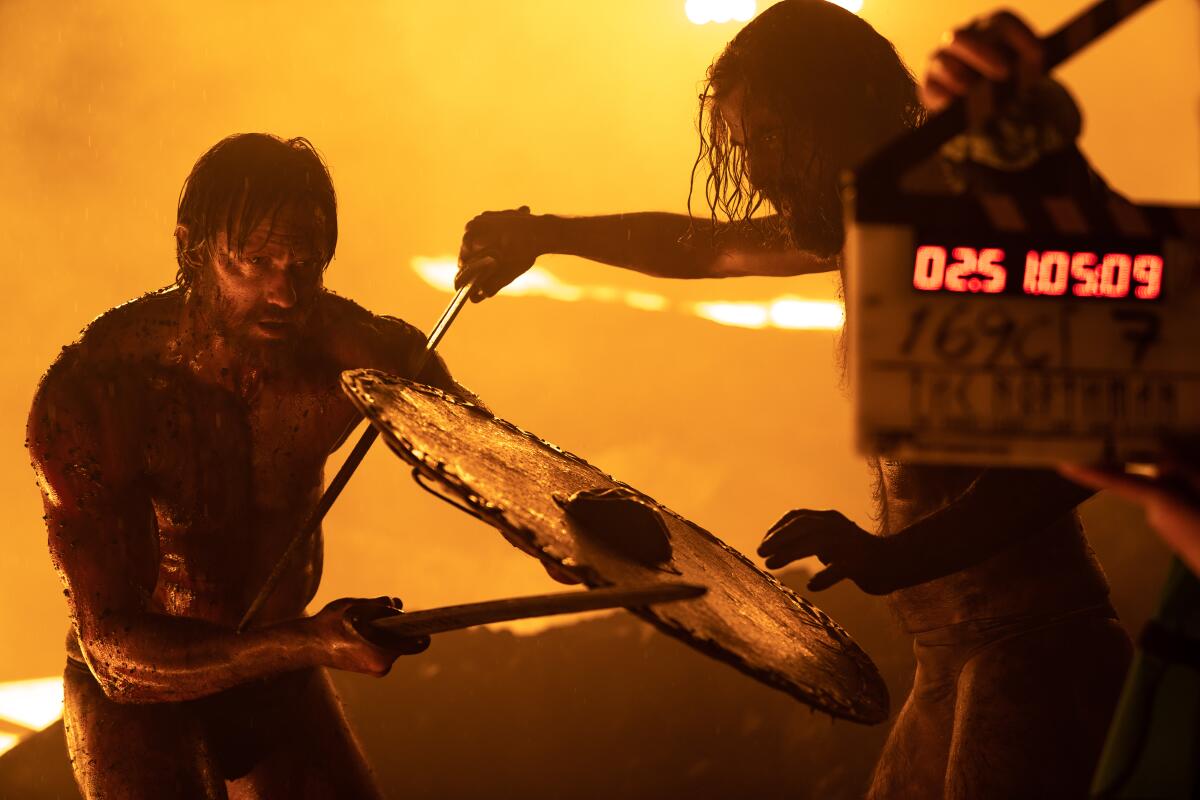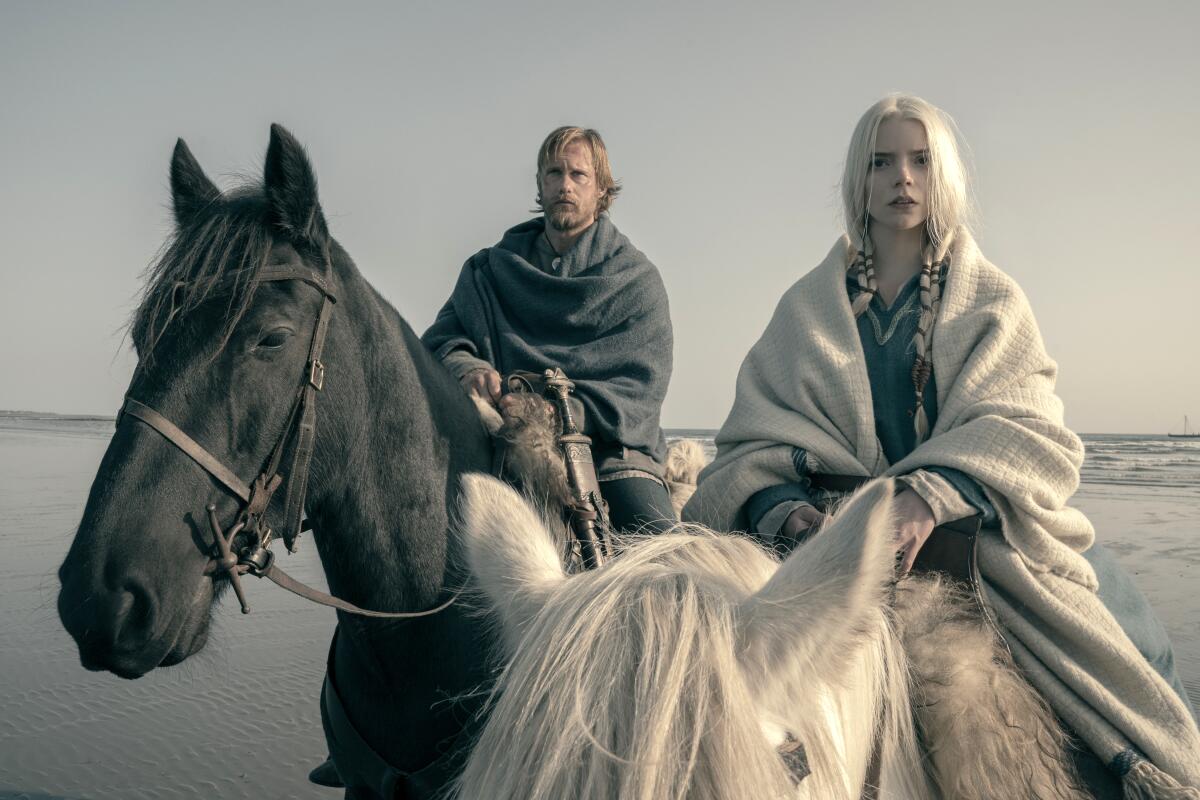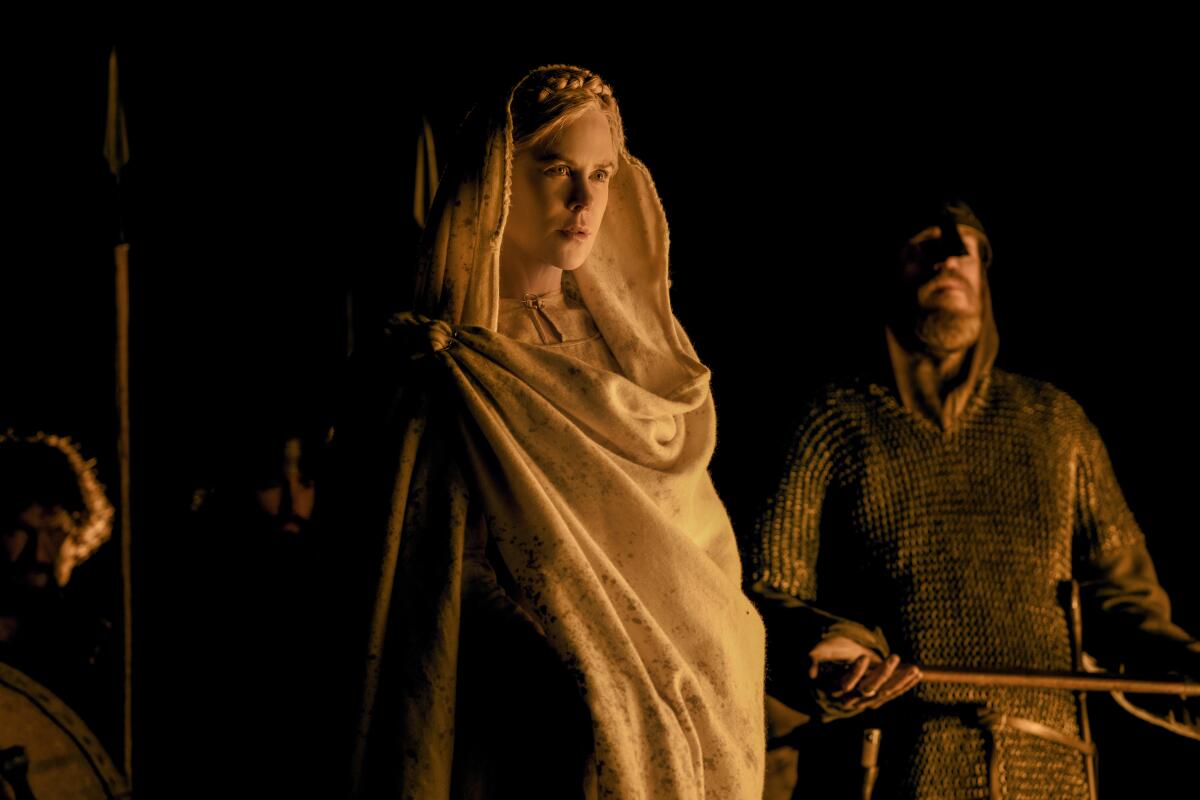Robert Eggers knew he’d have to fight for his vision of ‘The Northman.’ The result was worth it

- Share via
With his latest film, “The Northman,” director Robert Eggers is bringing his distinctive vision behind cult hits “The Witch” and “The Lighthouse” to something exponentially larger — a big-budget Viking epic. Opening in wide release from Focus Features this weekend, it’s a pressure-cooker test case of what happens when a definitively self-possessed filmmaker attempts to meet the Hollywood machine halfway.
Known for his eccentric and unnerving period pictures — bespoke objects made with an obsessive detail and oddball flair — Eggers collaborated with Icelandic author and poet Sjón on a story rooted in Medieval Icelandic sagas crossed with the Scandinavian legend of Amleth, an acknowledged precursor to “Hamlet.”
Set around the turn of the 10th century, “The Northman” follows young prince Amleth, who sees his father, King Aurvandil (Ethan Hawke), murdered by his uncle Fjölnir (Claes Bang) before Fjölnir steals away with Amleth’s mother, Queen Gudrún (Nicole Kidman). Twenty years later, Amleth (Alexander Skarsgård) has grown into a Viking warrior driven by his vow to avenge his father, save his mother and kill his uncle. Having disguised himself as a slave on Fjölnir’s farm to finish his quest, Amleth forms an unexpected bond with Olga of the Birch Forest (Anya Taylor-Joy, also in “The Witch”).
The world of the film is one of raw, shocking violence and an almost lyrical spirituality. Many scenes, including a brutal raid on a village, are shot in fluid, unbroken takes. The climactic battle takes place on the edge of a volcano.
“[My first] two films were at a scale where entertainment didn’t need to be my main objective,” Eggers said ahead of the film’s theatrical release. “‘The Lighthouse’ is a film that’s deliberately obscure, and this film, ‘The Northman,’ is a film that’s trying to be deliberately for a large audience.”

Shooting in the scenic landscapes of Northern Ireland, Eggers brought back key collaborators from his two previous films, including production designer Craig Lathrop, costume designer Linda Muir, cinematographer Jarin Blaschke and editor Louise Ford, to bring “The Northman” to life.
“What I’m trying to do is make a totally transportive period movie that explores the interior world of the period and makes the interior world and the exterior world a reality,” said Eggers. “And also something that strives to have a holistic cinematic language and a holistic cinematic approach. I understand that there’s a lot of hubris in saying this is what I’m after, but it is this idea that costume, sets, performance, camera work, it’s all one thing. It should all feel considered.”
A recent profile in the New Yorker went into extended detail on the film’s postproduction process, as Eggers tried to balance the demands of his financiers and studio with his own specific ideas. Having to respond to it now seems to put Eggers in a defensive position just as his big, ambitious movie is coming out. And yet he’s careful to stress the positive outcome of the behind-the-scenes conflict.
“Put my film aside. Everyone knows that people aren’t making big movies that aren’t superhero movies or franchise movies. So that alone is unique,” Eggers said. “And me and my collaborators, they let me use all my heads of department. We don’t have the résumé that says we can make this movie, so that’s amazing ... prep and production were just like a larger-scale version of what I’ve done before.
“Where things became different, and I knew this was going to be the case, was in postproduction. And I’ve said that it was the most painful thing I’ve experienced in my life, and, you know what, that’s a total fact,” he said.
“But also, I pitched that I would make the most entertaining Robert Eggers movie. Without the studio pressure and without my collaborators — Sjón spearheaded the cause, saying, ‘It’s our job to interpret the studio notes in a way that we’re proud of. And if we can’t do that, we’re not working hard enough.’ We got there. And we needed that pressure to make this movie the way it is — which, by the way, is the director’s cut — but it was hard.”

Eggers’ own journey to “The Northman” began shortly after “The Witch” premiered at the 2015 Sundance Film Festival — where Eggers won the directing prize — when he went with his wife on a vacation to Iceland. Through mutual friend Robin Carolan (who, along with Sebastian Gainsborough, composed the music for “The Northman”), Eggers met Björk, who would wind up playing a mystic seeress in “The Northman.”
It was Björk who introduced Eggers to Sjón, her longtime friend and collaborator. Eggers and Sjón hit it off and stayed in touch. Some time later, Eggers met with Skarsgård, also a producer on “The Northman,” who had long been trying to make a Viking story, along with “The Witch” producer Lars Knudsen.
“I had a big dream of making a Viking movie and trying to figure out a way to do it in a crazy big epic way. But at the same time, stay true to the essence of the poetry of the old Icelandic sagas,” said Skarsgård. “I’d never seen that movie. There’s been Viking projects out there and some of them are great, but I’d never seen one on a big canvas, a story told that actually didn’t feel like a modern-day interpretation of it but rather like a transportation back into the time and to where you actually experienced the world through a Viking’s eyes.”
Eggers reached out to Sjón, and the two set about researching and writing the screenplay, assembling a team of historians, archaeologists and Viking experts for support.
“As an Icelander, I had to approach the Icelandic sagas with a certain hesitation because it’s material that has been used so much here over the centuries. Immediately after they finish the sagas in the 13th century, people start rewriting them, changing them into epic poems, into plays and whatnot,” said Sjón. “And I wondered if I had anything new to contribute to it. But because it was Robert, I thought, ‘Well, he will definitely bring some fresh eyes on this, and I can then bring my poetry and insider knowledge to it.’
“None of the saga characters are heroic characters in the sense that they commit heroic deeds and that is why we remember them,” continued Sjón. “We remember them because they were amazingly flawed people who, despite their flaws, managed to do many good things but also many horrible things on the journey.”
Eggers’ father is a professor of Shakespeare, and Eggers himself has directed “Hamlet” onstage and even played the role, but he didn’t know its origins in the Scandinavian Amleth story. It was shortly after meeting Skarsgård, as he began digging into research, that Eggers saw the connection.
“This is a story that everybody knows,” Eggers said. “So I can explore and dare I say indulge in Viking religion and mythology and ritual culture without losing the audience because they all know the story of ‘Hamlet’ or ‘The Lion King.’”
“The beauty of working with this material, working with tried and tested narrative structures,” said Sjón, “is that of course we are not only having a dialogue with the Nordic culture and the original Amleth story, we are also paying our respect to good old William, and we placed elements from his well-written play here and there.”

While it is easy to focus on the superhuman physical challenges of Skarsgård’s role — the training, the climate, the nearly nude sword fight on the edge of a volcano — he still had to give an emotionally authentic performance. In particular, a pivotal scene where Amleth is reunited with his mother, Gudrún — Skarsgård and Kidman had played husband and wife on “Big Little Lies” — highlighted the challenge of moving between action set pieces and more nuanced character-driven scenes.
“I remember thinking what a treat this is as an actor, how rare it is that you get to fight naked on top of an erupting volcano and in the same film have a five-page, intimate dialogue scene with one of the greatest actors in the world,” Skarsgård said. “It’s often one or the other ... big popcorn action or small intimate indie. The fact that you can combine the two was such a privilege.”
Having seen his dream of making a Viking film come to fruition with “The Northman,” Skarsgård is also grateful to have been a part of shepherding Eggers’ idiosyncratic take to theaters.
“It’s exciting when someone takes a swing like this and makes a big movie for the masses with integrity,” said Skarsgård. “I’ve got nothing against franchise movies or blockbuster movies or sequels or prequels or remakes. I think it’s great that they’re out there. But I just wish that there was still a space somewhere between franchise movies and small European art house movies, that we can actually still make big-swing movies like this, where you don’t sit down and you know exactly what you’re going to watch and you’ve seen the characters 10 times before. It’s actually an immersive experience that takes you to another place and another time.”
With a long-planned adaptation of “Nosferatu” reportedly shelved, Eggers is vague as to what he might do next. But don’t expect a shift into contemporary stories or everyday settings.
“Why in the hell would that be any fun for me to do?” Eggers asked. “Everything that I have of interest to offer as a filmmaker I [wouldn’t] get to use, so what’s the point? Because the other thing is, I just enjoy research and making all this stuff.”
The same relentlessness that drives his desire for research, specificity and detail perhaps also drives Eggers to be most critical of himself.
“My skill as a filmmaker isn’t where I would like it to be,” Eggers said. “‘The Witch’ was my first feature, so I couldn’t get what was in my imagination onto the screen. And ‘The Lighthouse’ was just a tiny bump in scale but a large bump in budget. And I really was able to nail it, like I got what was in my imagination onto the screen. ‘The Northman’ is a mixed bag. Overall I’m pleased. And also given this complex post situation — whether the movie’s good or bad, whether you like it or not, I stand by my choices.
“Just because of my level of craft, I wasn’t able to get quite always what I was after,” he said of the ongoing struggle to get what’s in his head onto the screen. “And if that ever ends, then I should stop making films. ’Cause you need to be stretching or you might as well quit.”
More to Read
Only good movies
Get the Indie Focus newsletter, Mark Olsen's weekly guide to the world of cinema.
You may occasionally receive promotional content from the Los Angeles Times.











